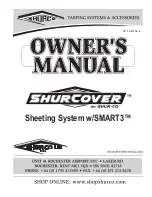
8/7/2019
ALL-T-2/4-GPT MANUAL
Copyright 2019 Vestil Manufacturing Corp.
Page 6 of 26
b. Releasing the lever causes to cylinder to stop extending. The cylinder maintains position wherever it stops.
Release the control lever as soon as the desired load elevation is achieved.
NOTE:
Do not continue to hold the control lever when the cylinder is completely extended. The hydraulic
fluid could overheat and cause permanent damage to the hydraulic system.
2.
Lower the fork carriage:
The engine does not have to be running to lower the carriage.
a. Pull the control lever towards you.
b. The carriage descends at a controlled speed. Releasing the lever causes the carriage to stop. It maintains
position wherever it stops. Lowering speed is adjustable. However, the lowering speed is optimized at the
factory. Do not change the lowering speed without approval from, and guidance by,
If the carriage lowers too quickly, a safety device in the cylinder, called a velocity fuse, closes. When the
fuse is closed, hydraulic fluid cannot flow from the cylinder to the reservoir. The cylinder cannot retract and
the carriage does not lower. If this happens, you must reset the velocity fuse by raising the hitch.
B. Tilting the carriage
Units equipped with the powered tilt feature (“-PT” appears in the
model designation) have two control levers.
1. The lever on the left controls up-and-down movement.
2. The lever on the left controls carriage tilt.
a. Push the lever forward to activate a second cylinder. This
cylinder pushes the top of the carriage forward, which
causes the fork tips to drop.
b. Pull back the lever to raise the tips and level the forks.
Before engaging the load:
1. Release the direction control lever.
2. Adjust the engine throttle to mid-speed.
3. Align the forks (on the carriage) with the fork channels in the pallet. The forks must be centered on the carriage.
4. Adjust the elevation of the forks with the Raise/Lower lever.
Mount the pallet on the forks:
1. Drive forward and insert the forks through the pallet. Insert the forks all-the-way. Fork length should be
at least
2
/
3
’s
of the parallel dimension of the pallet.
2. Raise the forks to elevate the pallet a few inches above the ground. Do not raise the forks any higher than
necessary.
3. Drive the load to the desired location. Instructions for driving and steering the truck are provided in
4. Set the pallet on the ground by lowering the forks. When the pallet rests on the ground, extract the forks from the
pallet by driving the truck in reverse.
LIFTING AND TRANSPORTING LOADS
Lower
Raise
Tilt
Level




























